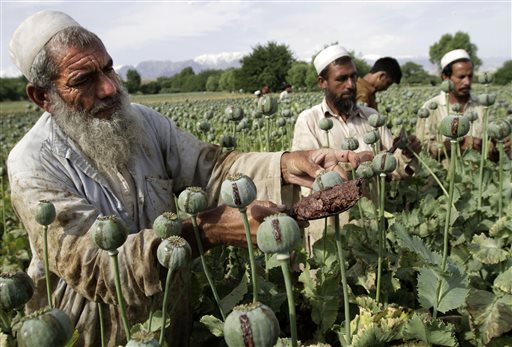UN says Afghan opium production hits record high

In this May 10, 2013 file photo, Afghan farmers collect raw opium as they work in a poppy field in Khogyani district of Jalalabad, east of Kabul, Afghanistan. Afghanistan’s opium production surged in 2013 to record levels, despite 12 years of international efforts to wean the country off the narcotics trade, according to a report released Wednesday by the U.N.’s drug control agency. AP
JALALABAD, Afghanistan — Afghanistan’s opium production surged this year to record levels, despite international efforts over the past decade to wean the country off the narcotics trade, according to a report released Wednesday by the U.N.’s drug control agency.
The harvest this past May resulted in a staggering 5,500 metric tons (6,060 tons) of opium, 49 percent higher than last year and more than the combined output of the rest of the world. Even Afghan provinces with some past successes in combating poppy cultivation saw those trends reversed, according to this year’s annual U.N. Office on Drugs and Crime (UNODC) report.
The withdrawal of foreign troops from Afghanistan next year is likely to make matters even worse, said Jean-Luc Lemahieu, the UNODC regional representative in Kabul. He warned that as international assistance falls off, the Afghan government will become increasingly reliant on illicit sources of income. Uncertainty is also driving up poppy production, as farmers worried about the country’s future turn to the tried and true.
The big increase in production began in 2010 when farmers rushed to plant to take advantage of soaring prices, a result of a crop disease the previous year, the U.S. military surge in the south and the announcement of the U.S. and NATO’s transition out of Afghanistan, Lemahieu told The Associated Press.
Lemahieu said those who benefit from the drug trade include farmers, insurgents and many within the government. Often, he said, they work together.
Article continues after this advertisement
In this photo taken Tuesday, Nov. 12, 2013, Afghan villagers take a break after preparing the soil for their poppy seeds in fields in Cham Kalai village in Afghanistan’s eastern Nangarhar province, an area which is largely controlled by Taliban. AP
Khan Bacha, who cultivates a small plot of land in eastern Nangarhar province, a Taliban stronghold, told the AP this week that the insurgents charge farmers a “religious tax” of one kilogram of opium for every 10 kilograms produced — though the price is “negotiable.”
Article continues after this advertisement“They say we are going for jihad,” Bacha said. “It is the God money we give.”
Past attempts by the international community to combat opium cultivation have included introducing alternative crops and paying farmers in some areas not to plant poppies. That backfired when farmers elsewhere started growing poppies in the hopes of getting money if they stopped.
Cultivation also appears to be spreading to new parts of the country — with Afghans planting poppies in some 209,000 hectares (516,450 acres) across 17 provinces this year, compared with 154,000 hectares (380,540 acres) in 15 provinces in 2012, according to the report.
The vast majority of Afghanistan’s poppy cultivation takes place in the south, southwest and east, areas where the Taliban insurgency is thriving. But Kabul province in central Afghanistan saw a major spike: a 148 percent increase in cultivation between 2012 and 2013.
But it wasn’t all bad news in the report, which said Afghanistan has expanded its social services to deal with a growing addiction problem at home.
“These are tangible and hopeful signs of improvement,” the report said.
There are roughly 1 million drug addicts in Afghanistan, 15 percent of whom are women and children, said Kanishka Turkistan, spokesman for the ministry of public health.
RELATED STORIES:
Afghanistan’s growing number of child drug addicts
Man dubbed ‘Godfather of Heroin’ dies in Myanmar